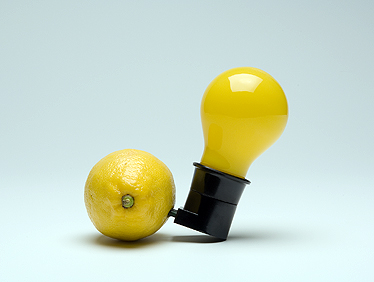 Courtesy: The National Museum of Art, Osaka
Courtesy: The National Museum of Art, Osaka
Photo: FUKUNAGA Kazuo"Capri Battery" 1985
Joseph BEUYSThis "object" work presents energy by connecting a lemon to an incandescent light bulb painted yellow. The lemon's acidity generates a weak electrical current, causing it to function as a battery, and illuminate the bulb. Although invisible on the surface of the bulb, the viewer is led to imagine this "light" as energy being generated. The pairing of the lemon -- having grown storing electromagnetic radiation from sunshine via photosynthesis, and now, as a detached fruit in the process of decomposition -- with the light bulb presents the existence of energy as something transformed and transported beyond simple assumptions of the natural and the artificial, in this unpredictable and vivid coupling. This was one of BEUYS' last works. Capri is the name of the island famous for its lemon production near Napoli. Collection of The National Museum of Art, Osaka. ProfileJoseph BEUYS (b. Kleve, Germany, 1921 and died Düsseldorf in 1986. As an artist working in the philosophical traditions of Johann Wolfgang von GOETHE and Rudolf STEINER, from the 1950s, BEUYS pursued a wide range of creative activities, including drawing, sculpture, "objects", and installations. His world-view was based on the flux of various energies such as heat, and his work often employed raw and unstable materials. Within the rubric of "social sculpture" he engaged in activities that forwarded social transformation in economics and the environment. In Japan, he held large-scale solo exhibition at the Seibu Museum in 1984.


 Courtesy: The National Museum of Art, Osaka
Courtesy: The National Museum of Art, Osaka